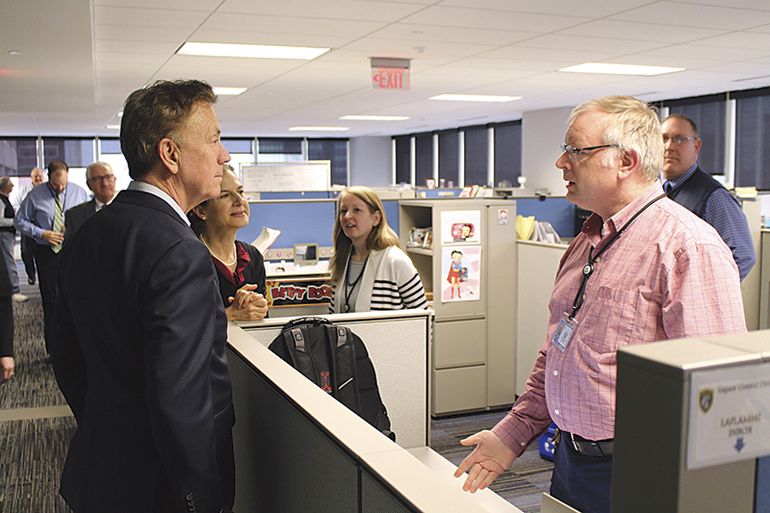
Processing Your Payment
Please do not leave this page until complete. This can take a few moments.
-
News
-
Editions
-
- Lists
-
Viewpoints
-
HBJ Events
-
Event Info
- 2024 Economic Outlook Webinar Presented by: NBT Bank
- Best Places to Work in Connecticut 2024
- Top 25 Women In Business Awards 2024
- Connecticut's Family Business Awards 2024
- What's Your Story? A Small Business Giveaway 2024 Presented By: Torrington Savings Bank
- 40 Under Forty Awards 2024
- C-Suite and Lifetime Achievement Awards 2024
- Connecticut's Health Care Heroes Awards 2024
-
-
Business Calendar
-
Custom Content
- News
-
Editions
View Digital Editions
Biweekly Issues
- April 29, 2024
- April 15, 2024
- April 1, 2024
- March 18, 2024
- March 4, 2024
- February 19, 2024
- February 5, 2024
- January 22, 2024
- January 8, 2024
- + More
Special Editions
- Lists
- Viewpoints
-
HBJ Events
Event Info
- View all Events
- 2024 Economic Outlook Webinar Presented by: NBT Bank
- Best Places to Work in Connecticut 2024
- Top 25 Women In Business Awards 2024
- Connecticut's Family Business Awards 2024
- What's Your Story? A Small Business Giveaway 2024 Presented By: Torrington Savings Bank
- 40 Under Forty Awards 2024
- C-Suite and Lifetime Achievement Awards 2024
- Connecticut's Health Care Heroes Awards 2024
Award Honorees
- Business Calendar
- Custom Content
How CT state gov’t scrambled to prepare its office employees for remote work
 HBJ Photo | Matt Pilon
Gov. Ned Lamont and Lt. Gov Susan Bysiewicz chat with Department of Consumer Protection liquor agent Richard Fedor during a tour last year of the agency.
HBJ Photo | Matt Pilon
Gov. Ned Lamont and Lt. Gov Susan Bysiewicz chat with Department of Consumer Protection liquor agent Richard Fedor during a tour last year of the agency.
Before the COVID-19 pandemic was the top issue facing the Lamont administration, Josh Geballe already had plans to ramp-up state government’s use of telecommuting.
In fact, the executive branch has been working since January to drastically beef up its remote-work IT infrastructure, said Geballe, who has been working both as commissioner of the Department of Administrative Services as well as Gov. Ned Lamont’s chief operating officer.
The timing was fortuitous.
“Adoption of new business practices and technologies is typically slow,” Geballe said. “[COVID-19] really helped us accelerate those plans. In many cases, we had no choice.”
The executive branch has approximately 32,000 employees, and of that number, roughly two-thirds have job duties that would be possible to perform from home, with the remainder holding frontline roles like state police and corrections officers.
As of January, the state had been plugging away at migrating its employees, agency by agency, to a Microsoft cloud-based software system. Approximately 2,500 employees were up and running on the cloud by the time it became clear the pandemic was Connecticut-bound.
DAS provided additional manpower and quickly increased the migration work so that more than 17,000 state employees could work remotely, Geballe said.
But the legacy systems used in a number of agencies aren’t readily available through the cloud. So DAS also had to add server capacity to expand how many employees could beam into their work machines from home using a virtual private network (VPN) connection.
“VPN went from 800 concurrent users before this to about 30,000 now,” Geballe said.
The VPN-related upgrades required a $250,000 investment, he said.
It’s not certain how many state workers might remain at home post-COVID-19, but Geballe predicts telework will gain more steam.
”I’m sure this will have accelerated the path we were on to more broadly embrace flexible work environments,” he said.
Another driving factor is that state employee unions have been pushing for telework in recent years.
A 3,000-member affiliate of the American Federation of Teachers and the AFL-CIO won an interim agreement last summer allowing its members to work from home for part of the week, the Yankee Institute reported.

Grinding through a pandemic with old tech
When Geballe, a former software entrepreneur, took the helm of DAS, Lamont tasked him with modernizing and streamlining the state’s IT infrastructure, both within state agencies and to improve the experience for taxpayers and other customers who interact with the state.
Geballe had been hard at work on those tasks, but there was much left to do when COVID-19 struck.
The pandemic has exposed some of the limitations of that technology.
“We’ve had to grind through the pandemic on some of our legacy systems,” Geballe said.
Perhaps the highest-profile struggle has been at the state Department of Labor, which is working overtime to process a massive wave of unemployment applications, which totaled more than 100,000 just last week, according to federal data released Thursday.
DAS sent developers, including one pulled out of retirement, to help DOL process a fix for its decades-old system that was triggering time-consuming manual reviews on too many applications, and creating a major processing backlog.
COVID-19’s timing was far from convenient.
“Before the pandemic hit, we were already halfway through a project to sunset that [DOL] system and replace it with a new, modern unemployment insurance system,” Geballe said. “If this had happened a year from now, we would have been on that new system.”
Timely virus reporting requires manual labor
Geballe said providing a constant flow of coronavirus data to the public in a timely manner is a crucial government function during a public-health crisis.
“The governor has been very clear that in this crisis we want to be transparent with the facts and data,” he said.
However, that task has presented technical headaches.
For example, the administration faced pressure to detail data on nursing home residents who tested positive for COVID-19 by location, which it released last week.
Geballe said compiling that information was difficult and “immensely time consuming” because the reporting by the individual facilities isn’t automated.
Similarly, laboratories that process COVID-19 tests don’t always report their data to the state in a uniform fashion.
“In some cases, it’s automatic through electronic health records and in other cases the team gets spreadsheets or other manual formats that must be manually entered,” he said. “As the volume of cases accelerated, the amount of time manually reporting the data has become substantial.”
In all, Geballe sees the pandemic as a “stark reminder” of Lamont’s previously stated mandate to improve the state’s IT infrastructure.
Pandemics are (hopefully) not going to be common, but systems must be able to handle those demands, if and when they arise.
“The Lamont digital strategy has been to embrace modern, cloud-based platforms that have the benefit of being highly flexible and highly scalable as opposed to legacy, on-premise custom-code solutions,” Geballe said. “One of the benefits is you can scale them up rapidly when the need demands it.”
“As we implement that strategy, we’ll be much better positioned to react to any future crises, but also to be able to scale down costs when it’s not required,” he added.
This implementation has been a disaster. Workers are expected to report every hour on their tasks to do nothing managers. Some departments do not have phones for client contact. DCF workers are using facetime but limited from other programs their clients use like Whatsapp to monitor safety. They are receiving emails from the Governor stating they are possibly returning June 1 with no idea if work space has been modified for social distancing. The same micromanaging and double talk exists for these teleworkers he is jonesing to get back to work to make sure they are being "watched" as we the taxpayers hear. Meanwhile workers were paid to stay home while all this chaos got figured out.

2022 Giving Guide
This special edition informs and connects businesses with nonprofit organizations that are aligned with what they care about. Each nonprofit profile provides a crisp snapshot of the organization’s mission, goals, area of service, giving and volunteer opportunities and board leadership.
Learn more
Subscribe
Hartford Business Journal provides the top coverage of news, trends, data, politics and personalities of the area’s business community. Get the news and information you need from the award-winning writers at HBJ. Don’t miss out - subscribe today.
Subscribe
2024 Book of Lists
Delivering Vital Marketplace Content and Context to Senior Decision Makers Throughout Greater Hartford and the State ... All Year Long!
Read Here-
2022 Giving Guide
This special edition informs and connects businesses with nonprofit organizations that are aligned with what they care about. Each nonprofit profile provides a crisp snapshot of the organization’s mission, goals, area of service, giving and volunteer opportunities and board leadership.
-
Subscribe
Hartford Business Journal provides the top coverage of news, trends, data, politics and personalities of the area’s business community. Get the news and information you need from the award-winning writers at HBJ. Don’t miss out - subscribe today.
-
2024 Book of Lists
Delivering Vital Marketplace Content and Context to Senior Decision Makers Throughout Greater Hartford and the State ... All Year Long!
ABOUT
ADVERTISE
NEW ENGLAND BUSINESS MEDIA SITES
No articles left
Get access now
In order to use this feature, we need some information from you. You can also login or register for a free account.
By clicking submit you are agreeing to our cookie usage and Privacy Policy
Already have an account? Login
Already have an account? Login
Want to create an account? Register
Get access now
In order to use this feature, we need some information from you. You can also login or register for a free account.
By clicking submit you are agreeing to our cookie usage and Privacy Policy
Already have an account? Login
Already have an account? Login
Want to create an account? Register






1 Comments